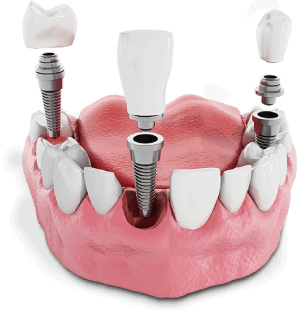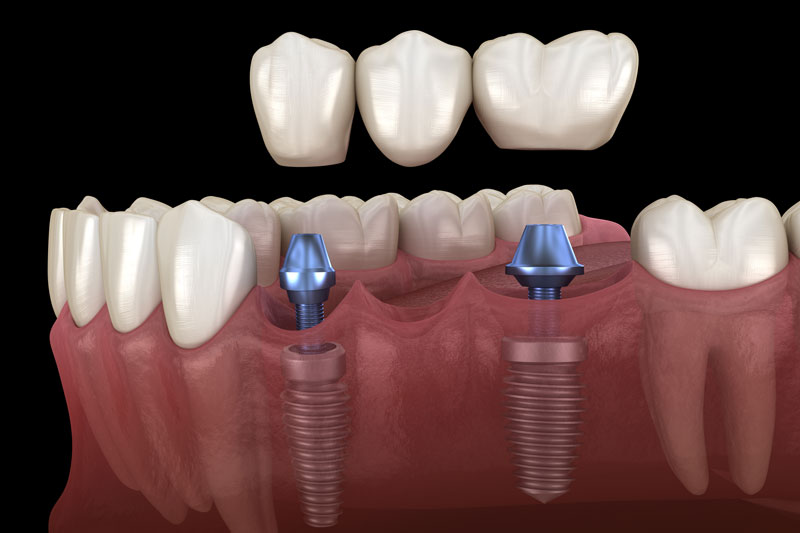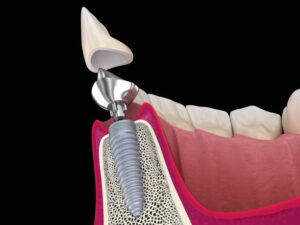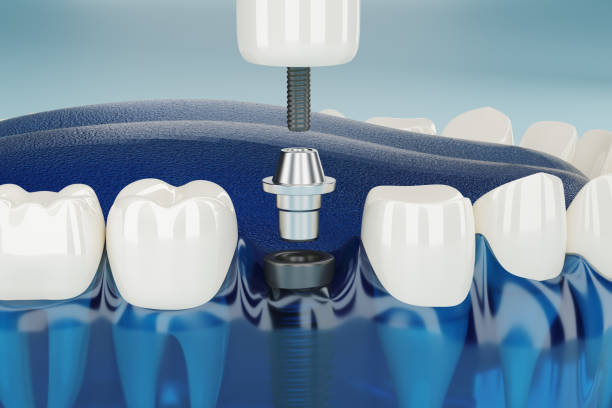What is a Dental Implant Abutment?
A dental implant abutment is a small connector that plays a key role in implant dentistry. It joins the dental implant, which is surgically placed into the jawbone, to the visible part of your new smile—the artificial tooth. This artificial tooth is often a dental crown, but it can also be a dental bridge or denture, depending on the type of implant used.
The abutment sits just above the gum tissue and helps hold your replacement tooth in place. Without it, the dental crown wouldn’t have a stable base. Whether you’re getting a single implant or a full-arch restoration, the abutment is what brings it all together—functionally and aesthetically.
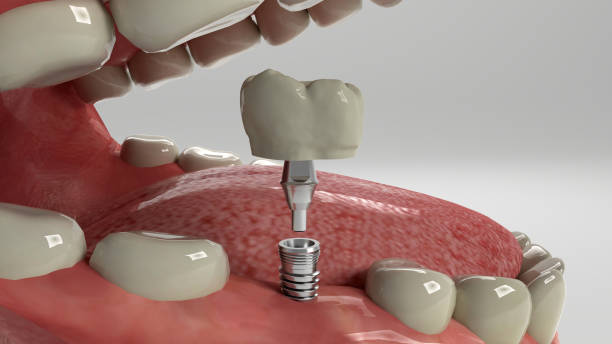
Why Dental Implants Need Abutments
Abutments are essential because they create the vital link between your dental implant and your new teeth. Once the implant fuses with your jawbone, the abutment acts like the neck of a tooth root, giving your prosthetic tooth a stable base to sit on.
Here’s why they matter:
Secure Support
The abutment connects the implant to the dental crown, bridge, or denture, holding your new teeth firmly in place.
Natural Function
Just like a tooth root, it supports biting and chewing without movement.
Custom Fit
Abutments are shaped to fit snugly against your gum tissue, which helps the prosthesis look and feel natural.
Restores Gaps
Whether you’ve lost one tooth or several, abutments help restore the function and appearance of missing teeth.
Works with Different Solutions
From a single crown to a full denture or dental bridge, the abutment adapts to the restoration used.
Without the abutment, the implant would remain buried below the gum line, unable to support a replacement tooth. It’s the part that makes your new smile possible.
Types of Abutments
There are two main types of abutments used in dental implant procedures:
Stock Abutments (Prefabricated Abutments): These are pre-made, standard-sized abutments often used as temporary abutments. While they offer a quicker solution, they may not always achieve the perfect fit, especially where gum and bone shapes vary.
Custom Abutments: These are individually designed to fit your mouth precisely and are typically used for permanent abutments. At FoX Implant Centre, we create custom abutments in our in-house dental laboratory. This allows us to control every detail, from shape to position, to make sure your final abutment fits seamlessly. This personalised approach enhances durability, aesthetics, and long-term comfort. We also use high-quality titanium, known for its high biocompatibility, to ensure that it integrates safely with your gum tissue.
When is a Dental Implant Abutment Placed?
During the entire course of your dental implant procedure, you will need a healing abutment and a permanent abutment. They are placed in different stages of your implant procedure.
Healing Abutment
A healing abutment, also called a healing cap, is a small, rounded component placed on top of the dental implant after surgery. It helps shape the gum tissue during the healing process and keeps the soft tissue from growing over the implant while the implant fuses with the jawbone. This stage is known as osseointegration.
Healing abutments are temporary abutments used between implant placement and the fitting of your final restoration. They help maintain access to the implant and guide the gum tissue into the right contour so your future dental crown, bridge, or denture can fit properly.
This abutment is usually placed after the implant surgery once initial healing has occurred, and it stays in place while the bone and implant integrate. This step is critical for setting up a healthy, functional environment for your final prosthetic tooth.
Permanent Abutment
Also known as the final abutment, this is placed after the healing process is complete. Once the implant has fully integrated with the jawbone and the gum tissue has stabilised, the healing abutment is removed and replaced with the permanent abutment.
This component supports the final prosthesis, which could be a dental crown, bridge, or denture. It’s designed to match the shape of your gum line and create a secure fit for your new tooth. At this stage, the dental implant is ready to function like a natural tooth, both in appearance and performance.
Understanding the Dental Implant Surgery
To truly understand the role of abutments and how they are placed, it helps to first understand what happens during the dental implant procedure. Abutments are just one part of a carefully staged process that begins with implant placement surgery.
The dental implant procedure starts with a thorough assessment. In some cases, grafting may be required to prepare the jawbone for an implant. Once your bone is ready, the implant is placed through a small incision in the gum. The implant is then left to heal and fuse with the jawbone—a process called osseointegration.
Once the implant is secure, the gum is reopened with a small incision to expose the implant. A healing abutment is then placed to help shape the gum tissue and allow the soft tissue to form a natural contour around it. This component also keeps the implant site accessible and protected during the healing period.
After osseointegration is complete and the gum tissue has stabilised, the healing abutment is removed. The final abutment is then secured onto the implant with a small screw. This permanent abutment is carefully adjusted to fit the shape of your gum line and align with your other teeth. It serves as the anchor for the final prosthesis, such as a dental crown, bridge, or denture, completing the restoration process.
At FoX Implant Centre, we are the only dental care provider in Australia offering complete end-to-end dental implant treatment. From your initial consultation through to surgery, implant placement, and crafting the final prosthesis, every step is done under one roof. This means you don’t need to visit separate clinics or labs. It’s all managed by the same experienced team who knows your case best.
What to Expect After Abutment Placement
Once the final abutment is in place, your gums may feel slightly tender or swollen for a few days. This is a normal part of the healing process as your gum tissue adjusts to the new shape and position of the abutment. Most patients return to their usual routine within a day or two.
During this stage, the dental team will take precise impressions to design your final prosthetic tooth. This is usually crafted from durable materials like acrylic, which not only looks natural but also stands up well to everyday use.
Once the prosthetic tooth is ready, it will be attached to the abutment. This completes the restoration and gives you a tooth that feels secure, looks natural, and functions just like the real thing.
Possible Complications and How to Avoid Them
While dental implant procedures are generally considered safe, some side effects and complications can occasionally occur. Most are minor and temporary, but it’s helpful to know what to watch for after abutment placement and during the healing process.
Common side effects include:
- Mild swelling or tenderness around the implant site
- Bruising on the gum or surrounding tissue
- Slight bleeding in the first 24 hours
- These are part of the normal healing process and usually resolve within a few days.
Potential complications may include:
- Infection around the implant site
- Gum tissue irritation or inflammation
- Abutment becoming loose
- Slower healing in patients with certain medical conditions or those who smoke
To help avoid these issues:
- Follow all post-op instructions closely
- Maintain good oral hygiene, including gentle brushing around the site
- Use mouthwash if recommended by your dentist
- Attend all follow-up appointments to monitor the healing process
Choosing a trusted provider like FoX Implant Centre also makes a big difference. With every step handled in-house by the same team, we monitor your recovery closely and step in early if any issues arise.
Best Practices for Long-Term Care and Hygiene
Caring for your dental implants and abutments long-term is just as important as the procedure itself. With the right habits, your replacement tooth can last as long as natural teeth and continue supporting your overall oral health.
Here are some key dental care tips:
- Brush twice a day using a soft-bristled toothbrush to gently clean around the implant and gum line.
- Floss daily or use interdental brushes to clean between your teeth and around the abutment.
- Use an antibacterial mouthwash to reduce plaque and maintain a healthy balance of oral bacteria.
- Schedule regular check-ups every six months so your dental team can assess the health of your implant and surrounding gum tissue.
- Avoid smoking, as it can slow the healing process and increase the risk of implant failure.
- Treat your implant like a natural tooth—it still needs daily care to prevent gum disease and other issues.

How Abutments Affect the Cost of Your Dental Implant
The material of the abutments, the type of abutment used, and the number of abutments necessary can affect the overall cost of your dental implants. Custom implants are obviously more expensive than prefabricated ones, and the more abutments you need, the higher the total cost may be. Titanium abutments may also slightly increase the price compared to other materials—but they offer better durability and long-term value.
At FoX Implant Centre, we include the design and production of custom final abutments as part of our all-inclusive approach. Everything is done in our in-house dental laboratory to make sure your final fit is accurate and long-lasting.
We also believe that high-quality dental care should be accessible. That’s why we offer flexible payment options, including interest-free plans through Humm and Total Lifestyle Credit (TLC). Eligible patients may also be able to access funding through their Super Fund. Our team is here to help you find the best option for your budget without compromising your care.
Setting the Foundation for a Lifetime of Smiles
Abutments might be small, but they play a crucial role in the strength, fit, and longevity of your dental implants. From the healing process to the final restoration, they help lay the foundation for a confident, lasting smile.
At FoX Implant Centre, we make the process straightforward, comfortable, and reliable by offering complete end-to-end care under one roof. No referrals. No delays. Just seamless care from a team that knows your smile best.
Book a consultation with our experienced team today to learn how dental implants and customised abutments can restore your smile and improve your oral health for life.
Get implant pricing and financing options,
Including your superfund!
Find Out If You're A Candidate!
